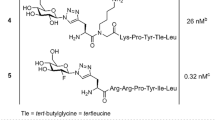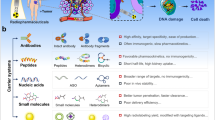Abstract
The in vivo targeting efficacy of small molecule analogs of nerve growth factor (NGF) that bind the NGF receptor p140 TrkA was evaluated and compared with that of a high-affinity anti-TrkA monoclonal antibody (Mab 5C3). Nuclear imaging studies were done after the injection of 99mTc-labeled compounds in nude mice bearing tumors. Kinetics of tumor targetting, blood clearance, and bioavailability of NGF mimics were equivalent or better than Mab 5C3. Tumors that do not express TrkA were not targeted, demonstrating the specificity of NGF mimics in vivo. This comparative biodistribution study demonstrates that receptor-specific small molecule analogs designed from large polypeptides may be more useful than antibodies and may be effective agents for the detection, diagnosis, and possible treatment of neoplasias involving overexpressed oncogenic receptors such as TrkA.
This is a preview of subscription content, access via your institution
Access options
Subscribe to this journal
Receive 12 print issues and online access
$209.00 per year
only $17.42 per issue
Buy this article
- Purchase on Springer Link
- Instant access to full article PDF
Prices may be subject to local taxes which are calculated during checkout
Similar content being viewed by others
References
Schwartz, D.A., Abrams, M.J., Mauser, M.M., Gaul, F.E., Larsen, S.K., Rauh, D. et al. 1991. Preparation of hydrazino-modified proteins and their use for the synthesis of 99mTc-protein conjugates. Bioconjugate Chemistry 2: 333–336.
Saragovi, H.U. and Greene, M.I. 1992. Constrained peptides and mimetics as probes of protein secondary structure. Immunomethods 1: 3–12.
Zhang, X., Piatier-Tonneau, D., Auffray, C., Murali, R., Mahapatra, A., Zhang, F. et al. 1996. Synthetic CD4 exocyclic peptides antagonize CD4 holoreceptor binding and T cell activation. Nature Biotechnology 14: 472–475.
Barbacid, M. 1994. The Trk family of neurotrophin receptors. J. Neurobiol. 25: 1386–1403.
Nakagawara, A., Arima-Nakagawara, M., Scavarda, N.J., Azar, C.G., Cantor, A.B. and Brodeur, G.M. 1993. Association between high levels of expression of the Trk gene and favorable outcome in human neuroblastoma. N. Engl. J. of Med. 328: 847–854.
Oelman, E., Sreter, L., Schuller, I., Serve, H., Uoenigsann, M., Wiedmann, B. et al. 1995. Nerve growth factor stimulates clonal growth of human lung cancer cell lines and a human glioblastoma cell line expressing high affinity nerve growth factor binding sites involving tyrosine kinase signalling. Cancer Res. 55: 2212–2219.
Marchetti, D., Menter, D., Jin, L., Nakajima, M. and Nicolson, G.L. 1993. Nerve growth factor effects on human and mouse melanoma cell invasion and hepa-ranase production. Intl. J. Cancer 55: 692–699.
LeSauteur, L., Wei, L., Gibbs, B. and Saragovi, H.U. 1995. Small peptide mimics of nerve growth factor bind TrkA receptors and affect biological responses. J. Biol. Chem. 270: 6564–6569.
LeSauteur, L., Wei, L., Gibbs, B. and Saragovi, H.U. 1996. Small peptide mimics of nerve growth factor bind TrkA receptors and affect biological responses (addition and correction). J. Biol. Chem. 271: 249.
LeSauteur, L., Maliartchouk, S., LeJeune, H., Quirion, R. and Saragovi, H.U. 1996. Potent human p140-TrkA agonists derived from an anti-receptor monoclonal antibody. J. Neurosci. 16: 1308–1316.
Jing, S., Tapley, P. and Barbacid, M. 1992. Nerve growth factor mediates signal transduction through Trk homodimer receptors. Neuron 9: 1067–1079.
Yasumura, Y., Buonsassisi, V. and Sato, G. 1966. Clonal analysis of differentiated function in animal cell cultures. I. Possible correlated maintenance of differentiated function and the diploid karyotype. Cancer Res. 26: 529–535.
Michitsch, R.W., Biedler, J.L. and Melera, P.W. 1988. Modulation of N-myc expression, but not tumorigenicity, accompanies phenotypic conversion of neuroblastoma cells in prolonged culture, pp. 103–120 in Advances in neuroblastoma research 2. Evans, A.E., D'Angio, G.J., Knudson, A.G., and Seeger, R.C. (eds.). Progress in clinical and biological research. Vol 271. Alan R. Liss, Inc, NY.
Fujimori, K., Fisher, D.R. and Weinstein, J.N. 1991. Integrated microscopic/macroscopic pharmacology of monoclonal antibody radioconjugates: the radiation dose distribution. Cancer Res. 51: 4821–4827.
Lomen-Hoerth, C. and Shooter, E.M. 1995. Widespread neurotrophin receptor expression in the immune system and other non-neuronal rat tissues. J. Neurochem. 64: 1780–1789.
Esteban, I., Hannestad, J., Levanti, B., DelValle, M.E., Naves, F.J. and Vega, J.A. 1995. Neurotrophin receptor proteins immunoreactivity in human gastrointestinal endocrine cells. Brain Res. Bulletin 38: 539–543.
Trail, P.A., Willner, D., Lasch, S.J., Henderson, A.J., Hofstead, S., Casazza, A.M. et al. 1993. Cure of xenografted human carcinomas by BR96-doxorubicin Immunoconjugates. Science 261: 212–215.
Cheung, N.K., Kushner, B.H., Yeh, S.J. and Larson, S.M. 1994. 3F8 monoclonal antibody treatment of patients with stage IV neuroblastoma: a phase II study. Progress in Clinical and Biological Research 385: 319–338.
Saragovi, H.U., Fitzpatrick, D., Raktabutr, A., Nakanishi, H., Kahn, M. and Greene, M.I. 1991. Design and synthesis of a mimetic from an antibody complementarity-determining region. Science 253: 792–795.
Saragovi, H.U., Greene, M.I., Chrusciel, R.A. and Kahn, M. 1992. Loops and secondary structure mimetics: development and applications in basic science and rational drug design. Bio/Technology 10: 773–778.
Kramer, K., Gerald, W., LeSauteur, L., Saragovi, H.U. and Cheung, N.-K.V. 1996. Prognostic value of TrkA protein detection by monoclonal antibody 5C3 in neuroblastoma. Clin. Cancer Res. In press.
King, T.R., Zhao, S.W. and Lam, T. 1986. Preparation of protein conjugates via intermolecular hydrazone linkage. Biochemistry 25: 5774–5779.
Author information
Authors and Affiliations
Rights and permissions
About this article
Cite this article
LeSauteur, L., Cheung, NK., Lisbona, R. et al. Small molecule nerve growth factor analogs image receptors in vivo. Nat Biotechnol 14, 1120–1123 (1996). https://doi.org/10.1038/nbt0996-1120
Received:
Accepted:
Issue Date:
DOI: https://doi.org/10.1038/nbt0996-1120
This article is cited by
-
Pharmacokinetics and biodistribution of a small radioiodine labeled nerve growth factor fragment
Annals of Nuclear Medicine (2006)
-
Minimized hormones grow in stature
Nature Biotechnology (1996)



